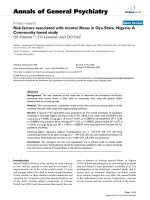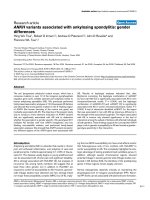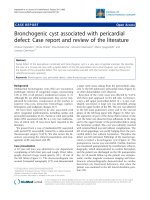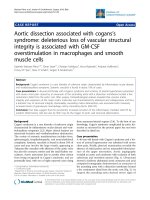Báo cáo y học: "Clinical Symptoms Associated with Asystolic or Bradycardic Responses on Implantable Loop Recorder Monitoring in Patients with Recurrent Syncope"
Bạn đang xem bản rút gọn của tài liệu. Xem và tải ngay bản đầy đủ của tài liệu tại đây (568.77 KB, 5 trang )
Int. J. Med. Sci. 2009, 6
106
I
I
n
n
t
t
e
e
r
r
n
n
a
a
t
t
i
i
o
o
n
n
a
a
l
l
J
J
o
o
u
u
r
r
n
n
a
a
l
l
o
o
f
f
M
M
e
e
d
d
i
i
c
c
a
a
l
l
S
S
c
c
i
i
e
e
n
n
c
c
e
e
s
s
2009; 6(2):106-110
© Ivyspring International Publisher. All rights reserved
Research Paper
Clinical Symptoms Associated with Asystolic or Bradycardic Responses on
Implantable Loop Recorder Monitoring in Patients with Recurrent Syncope
Khalil Kanjwal, Yousuf Kanjwal, Beverly Karabin, Blair P. Grubb
Department of Medicine, University of Toledo Medical Center, Toledo OH 43614, USA
Correspondence to: Blair P Grubb, MD, Director Electrophysiology Services, Division of Cardiology, Department of
Medicine, Health Sciences Campus, University of Toledo Medical Center, Mail Stop 1118, 3000 Arlington Ave, Toledo OH
43614, USA
Received: 2009.02.16; Accepted: 2009.04.08; Published: 2009.04.09
Abstract
Background: Implantable loop recorders (ILR) have been found to be useful in the diagnosis
and management of syncope of unclear etiology. The clinical symptoms of abnormalities seen
during ILR monitoring have not been adequately studied.
Aim: The aim of this retrospective study was to determine the clinical symptoms which were
the best predictors of asystolic or bradycardic responses during ILR monitoring.
Methods: Patients with either asystole or bradycardia recorded during ILR monitoring were
analyzed from our database. The clinical characteristics of these patients were compared to
the patients with ILR’s who did not have recorded bradycardic episodes. The episodes were
characterized as being convulsive or nonconvulsive, brief (<5 minutes) or prolonged (> 5
minutes), and having had a prodrome or no prodrome.
Results: Eleven patients (4 males and 7 females; age 39 ±11years) had asystole or bradycardia
on ILR monitoring. Eleven patients (2 males and 9 females; age 46±23) had no bradycardiac
events. Palpitations, convulsive syncope, prolonged episode, and prodrome were present in
37% vs. 74% (P = 0.125), 62% vs. 0% (P = 0.002), 87% vs. 0% (P=0), and 73% vs. 13%
(P=0.009) patients, respectively, in the asystole/bradycardia and non-bradycardia groups. In
the asystole/bradycardia group eight patients had bradycardia (HR < 20) for > 10 seconds
and three patients had asystole >10 seconds.
Conclusion: Convulsive syncope, prolonged loss of consciousness during syncopal episode,
and absence of prodrome or aura are clinical predictors of asystole or bradycardia on ILR
monitoring.
Key words: Implantable loop recorders, bradycardia, asystole, convulsions.
Introduction
Ambulatory cardiac monitoring with Holter or
external loop recorders is frequently employed in the
evaluation of patients with recurrent syncope. How-
ever, several non-randomized studies demonstrate a
relatively low (<40%) diagnostic yield from this ap-
proach [1-5]. Implantable loop recorders (ILR’s), by
contrast, allow for a more prolonged period of moni-
toring as well as automatic activation during events,
resulting in a higher diagnostic yield than traditional
monitoring techniques [6-12].
During ILR monitoring
of patients with recurrent syncope, bradycardic
events are encountered more frequently than are
tachycardiac ones [13-15]. The clinical symptoms most
predictive of significant bradycardic events (such as
prolonged sinus pauses or complete heart block) re-
corded during ILR monitoring have not been well
Int. J. Med. Sci. 2009, 6
107
reported. The aim of the present study was to identify
the clinical characteristics and symptoms obtained
from patient histories that best correlate with signifi-
cant bradycardic events recorded during ILR moni-
toring.
Methods
The study was a retrospective analysis which
was approved by the University of Toledo Institu-
tional Review Board. A comprehensive review of pa-
tient charts was performed to identify patients of un-
explained syncope who had received ILR and had
asystolic (>10 second pause) or bradycardic (< 20
beats per minute) response corresponding to syncopal
event during ILR monitoring.
Inclusion criterion
We queried our data base of implanted loop re-
corders. We identified 150 patients who received ILR
over a period of 8 years for evaluation of unexplained
nature of their syncope. Out of these 150 patients only
14 had either a bradycardic (n=11) or a tachycardiac
response (n=3) recorded on ILR during episodes of
syncope. Patients were included in the study if they
had either syncope or symptoms during monitoring
which resembled the index syncope episode that lead
to evaluation. Patients included in the study had un-
dergone an extensive evaluation including head up
tilt test, cardiac electrophysiology study and 24 hour
holter monitor and 1 month event recorder prior to
implantation of ILR. Another 8 patients who had re-
ceived loop implants during the same time frame and
had no arrhythmia recorded during an episode of the
syncope were also include to make groups compara-
ble. These patients were followed for a period of 9±3
months after rhythm directed therapy for recurrence
of any syncope.
The information about the clinical symptoms
was obtained from patient charts and physician let-
ters. The clinical symptoms which were obtained from
these sources included
1. Presence of Aura: Aura included subjective
nature of symptoms like lightheadedness, dizziness
feeling of passing out. It was considered present or
absent if the patient had aura during the episode of
syncope (while being on ILR monitoring) and resem-
bled the index episode.
2. Duration of syncope: The duration of syncope
was determined from the loss of consciousness to full
recovery of consciousness. The duration also included
the postictal confusion if it was a convulsive syncope.
We defined episodes of loss of consciousness as pro-
longed if they were > 5 minutes. The estimate of du-
ration of loss of consciousness was obtained from the
people witnessing the event
3. Convulsive Syncope. Syncopal episodes were
labeled as convulsive if the patients had convulsions
during the episodes. These convulsions were myo-
clonic in nature and were witnessed by family mem-
bers or friends. None of our patients had loss of
bladder or bowel controls during these episodes.
4. Palpitations: Patient histories were reviewed
for presence or absence of palpitation immediately
prior to syncope. Due to the specific nature of palpi-
tations this symptom was not included in the aura.
Statistics
All statistical analyses were done using SPSS.
The continuous data was presented as mean ±SD and
categorical data as percentages. T-test for comparison
of means and chi-square test for categorical data was
used. Significance was achieved with P value < 0.05.
Results
Total of 22 patients of refractory syncope were
included in this study. These patients had suffered
from recurrent episodes of syncope (> 2 in 6 months).
All of these patients had a negative work-up includ-
ing head up tilt test (HUTT), 24 hour holter, 30 day
event monitor and cardiac electrophysiology studies.
Some of these patients had undergone stress and
coronary angiography as well as electroencephalo-
graphy and CT scan. All the evaluations turned out to
be inconclusive. In view of negative initial inconclu-
sive work-up patients received implantable loop re-
corders. The average duration of monitoring with an
ILR was 6 months.
The baseline clinical characteristics of patients
with asystolic or bradycardic responses during ILR
monitoring (Group 1) are compared with those with-
out asystolic or bradycardic responses (Group 2) in
Table 1. Eleven patients (4 males and 7 females; age 39
±11) had asystole or bradycardia on ILR monitoring.
Eight patients had bradycardia (HR < 20) for > 10
seconds and 3 patients had asystole >10 seconds in
group 1.
Eleven patients in group 2 (2 males and 9 fe-
males; age 46±23) had either tachycardia (n=3) or a
sinus rhythm (n-8) recorded during an episode syn-
cope.
One patent with tachycardia in Group 2 had
Ventricular Tachycardia (HR > 140) and episodes of
atrial fibrillation (HR 180). Two patients had atrio-
ventricular re-entrant tachycardia with HR (200).
These episodes of arrhythmias either tachycardia
or bradycardia were associated either with syncope
during ILR monitoring.
Int. J. Med. Sci. 2009, 6
108
Table 1: Baseline clinical characteristics in two groups of
patients
Clinical Characteristics Group1 (N=11) Group 2 (N=11) P
Age 39±11 46±23 NS
Race (Caucasian)% 90 94 NS
Male: Female 4:7 2:9 NS
Symptoms
Palpitations % 37 74 0.125
Convulsive syncope % 62 0 0.002
Episode > 5 min. % 87 0 0.001
Prodrome % 13 73 0.009
Group 1= Patients with asystolic or bradycardic response on ILR
monitoring.
Group 2= Patients without asystolic or bradycardic response on ILR
monitoring.
Symptoms (Table 1 and Figure 1)
1. Aura or prodrome: Only thirteen percent of
patients in group1 had aura or warning signs before
syncope compared to 73% in group 2 (p=0.01).
2. Duration: Eighty seven percent of patients in
group 1 had prolonged episode compared to none in
group 2 (p=0.0001).
3. Palpitations: Thirty seven percent of patients
in group 1 had palpitations compared to 74% in group
2 (p=0.12).
4. Convulsive Syncope. Convulsive syncope was
seen in 62% of patients in group1 and none in group 2
(p=0.002).
Age, gender, and race were similar in the two
groups. In this study, fourteen patients had positive
testing on ILR monitoring. In group 1, eight patients
had bradycardia (HR < 20) for > 10 seconds and three
patients had asystole >10 seconds. One of the patients
had a 44-second sinus pause on ILR monitoring (Fig
2). Dual chamber pacemaker was placed in all eleven
patients in group 1 in view of either asystole or com-
plete AV block recorded on ILR during a syncopal
episode. Two patients in group 2 who were noted to
have supraventricular tachycardia underwent ra-
diofrequency ablation therapy. The patient with ven-
tricular tachycardia and atrial fibrillation received an
implantable cardioverter defibrillator as well as
medical management for paroxysmal atrial fibrilla-
tion. Following rhythm directed therapy, none of
these patients had any further episodes of syncope
over 6±3 months.
37
74
87
0
62
0
13
73
0
10
20
30
40
50
60
70
80
90
Palp Prol Conv Prod
Group1
Group2
Palpitation
Prolonged
Episode
Prodrome
NS
P=0
P=0.002
P=0.01
Convulsive
Episode
Percentage of Patients
Figure 1: Clinical presentation of patients in different groups.
Int. J. Med. Sci. 2009, 6
109
Figure 2: Recording downloaded from loop recorder showing prolonged Ventricular asystole and profound AV block. (44
second).
Discussion
Unexplained syncope can pose a unique diag-
nostic challenge for physicians especially when the
initial workup such as HUTT, electrophysiology
studies, 24 hour holter monitor or 30 day event re-
corder is inconclusive. Implantable loop recorders
have been shown to improve diagnosis and, thus fa-
cilitate rhythm directed therapy in this subgroup of
patients [3-16]. In our study of 22 patients, 14 had an
arrhythmic etiology. Eleven patients had bradyar-
rhythmia on ILR monitoring.
Our study is unique as the clinical symptoms of
the syncope in patients with bradyarrhythmic re-
sponses (the most common arrhythmia that has been
reported during prolonged monitoring with ILR)
have not been studied to date. It is interesting that
abrupt onset (lack of prodrome), convulsive activity,
and prolonged episodes of loss of consciousness were
significantly associated with bradycardic responses
during ILR monitoring. Interestingly, some of the
patients in our study were labeled as having psycho-
genic syncope for years before the ILR monitoring
revealed the diagnosis. The result of the recurrent and
unpredictable nature of these syncopal episodes can
result in a marked reduction in the quality of life in
many of these patients [17].
Syncope can sometimes be confused with sei-
zures. Some studies have reported that 30-42% of pa-
tients who were initially diagnosed with epilepsy had
syncope with convulsive activity due cardiovascular
etiology [20, 21, 22]. The pathophysiology of syncope
provoked convulsive activity is complex. Asystole
and sinus pauses in our patients were long enough to
result in severe hypotension and cerebral hypoxia,
which in turn could have lead to convulsive activity.
Engel et al [23] reported seizure-like activity following
periods of cerebral hypoxia. It has also been reported
that in episodes of syncope associated with convul-
sive activity, the duration of loss of consciousness
tends to be longer, as is the time to full recovery. In
our study, these episodes lasted more than 5 min from
onset to full return of consciousness (including pos-
tictal confusion period). In addition, all our patients
who had a bradycardic/asystolic response on ILR
monitoring had abrupt onset of syncope with no pro-
drome or aura, which predisposed them to suffer
trauma from an episode. Sud et al [24] in their recent
Int. J. Med. Sci. 2009, 6
110
report of predicting cause of syncope from clinical
histories found that syncope occurring without aura
or prodrome is associated with spontaneous ar-
rhythmic etiology predominantly bradycardia.
Given a small number of patients in our study
population and retrospective nature of the study an
adequately powered prospective study is needed to
validate these results, nevertheless the results of our
study are consistent with those of other studies
[13-15,23,24].
In our study, ILR monitoring by guiding rhythm
directed therapy in all patients who tested positive
helped prevent further syncope. None of the patients
has yet had recurrence of their syncope following
definitive treatment.
Limitation
This study was retrospective in nature and fol-
lowed a small number of patients. The information
about the clinical symptoms was obtained from pa-
tient charts and physician letters. There was no ques-
tionnaire used to assess the symptoms. Another limi-
tation of the study was a recall bias on the part of
family members or friends witnessing these episodes.
The study included only patients with unexplained
syncope and thus the results can not be generalized.
Conclusion
In the group of patients with recurrent unex-
plained syncope, severe bradycardia/asystole was the
most common positive finding recorded during ILR
monitoring. The clinical symptoms that were found to
have the consistent association with severe bradycar-
dia and asystole include lack of prodrome, convulsive
activity and prolonged loss of consciousness.
Conflict of Interest
The authors have declared that no conflict of in-
terest exists.
References
1. Kapoor WN. Evaluation and outcome of patients with syncope.
JAMA 1990; 69: 160-175.
2. Soteriades ES, Evans JC, Larson MG, et al. Incidence and
prognosis of syncope. N Engl J Med 2002; 347:878–885.
3. Sarasin FP, Louis-Simonet M, Carlballo D, et al. Prospective
evaluation of patients with syncope: a population based study.
Am J Med. 2001; 111:177-184.
4. Linzer M, Yang EH, Estes NA. Diagnosing syncope. Part 2:
Unexplained syncope. Clinical efficacy assessment project of
the American college of physicians. Ann Intern Med. 1990; 150:
1073-1078.
5. Gibson TC, Heitzman MR. Diagnostic efficacy of 24 hour elec-
trocardiographic monitoring for syncope. Am J cardiol. 1984;53:
1013-1017.
6. Linzer M, Pritchet EL, Pontinen M. Incremental diagnostic yield
of loop electrocardiographic recorders in unexplained syncope.
Am J of Cardiol.1990; 66:214-219.
7. Cumbee SR, Pryor RE, Linzer M. Cardiac loop ECG recording: a
new non-invasive diagnostic test in recurrent syncope. South
Med J. 1990; 83:39-43.
8. Brown AP, Dawkins KD, Davies JG. Detection of arrhythmia.
Use of patient activated ambulatory electrocardiogram device
with a solid state memory loop. Br Heart J. 1987; 58:251-253.
9. Zimetbaum P, Kime KY, Ho KK. Utility of patient activated
cardiac event recorders in general clinical practice. Am J Car-
diol. 1997; 79: 1-372.
10. Krahn AD, Klein GJ, Yee R, Hoch JS, Skanes AC. Cost Implica-
tion of Testing strategy in patients with syncope. Randomized
Assessment of Syncope Trial. J Am Coll Cardiol. 2003; 42:
495-501.
11. Schuchert A, Maas R, Kretzschmar C, Behrens G, Kratzman I,
Meinertz T. Diagnostic yield of external electrocardiographic
loop recorders in patients with recurrent syncope and negative
Tilt table test. PACE. 2003; 26: 1837-1840.
12. Farwell DJ, Freemantle N, Sulke AN. Use of implantable loop
recorders in the diagnosis and management of Syncope. Euro-
pean Heart Journal 2004; 25: 1257-1263.
13. Moya A, Brignole M, Mennozi C, et al. Mechanism of syncope
in patients with isolated syncope and in patients with tilt posi-
tive syncope. Circulation 2001; 104:1261-1267.
14. Brignole M, Mennozi C, Moya A, et al. Mechanism of syncope
in patients with bundle branch block and negative electro-
physiological tests. Circulation 2001; 104:2045-2050.
15. Inamdar V, Mehta S, Juang G, Cohen T. The utility of implant-
able loop recorders for diagnosing unexplained syncope in 100
consecutive patients – Five year, Single Center Experience. J
invasive cardiol. 2006; 18(7):313-315.
16. Menozzi C, Bringole M, Garcia –Civera R. Mechanism of syn-
cope in patients with heart disease and negative electrophysi-
ologic test. Circulation 2002, 105:2741-2745.
17. Grubb BP. The impact of syncope and transient loss of con-
sciousness on quality of life. In: Benditt D, Bringole M, Raviele
A, Wieling W, eds. Malden MA: Blackwell- futura Publishing.
2007:148-152
18. Frangini PA, Cecchin F, Jordao L, Martuscello M, Alexander
ME, Triedman JK, Walsh EP, et al. How Revealing Are Insert-
able Loop Recorders in Pediatrics? PACE. 2008, 31 (3):338-343.
19. Giada F, Gulizia M, Francese M, Croci F, Santangelo L, San-
tomauro M, Occhetta E, Mennozi C, Raviele A. Recurrent un-
explained palpitations (RUP) study. J Am Coll Cardiol.
2007;
49(19):1951-6.
20. Gastaut H, Gastaut Y. Electroencephalographic and clinical
study of anoxic convulsions in children: their location within
the group of infantile convulsions and their differentiation from
epilepsy. Electroencephalogr clin Neurophysiol. 1958;
10:815-835
21. Zaidi A, Clough P, Cooper P. Misdiagnosis of epilepsy: Many
seizures like episodes have cardiovascular cause. J Am Coll
Cardiol. 2000;36:181-184.
22. Zaidi A, Clough P, Marwer G et al. Accurate diagnosis of con-
vulsive syncope: Role of implantable subcutaneous ECG
monitoring. Seizure 1999;8:184-186
23. Engel J. Differential diagnosis of seizures. In: Engel JJr, ed.
Seizures and epilepsy. Philadelphia: FA Davis Co. 1998:340-1.
24. Sud S, Klein GJ, Skanes AC, Gula LJ, Yee R, Krahn AD.
Predicting the cause of syncope from clinical history in patients
undergoing prolonged monitoring. Heart Rhythm. 2009;
6(2):238-43.








